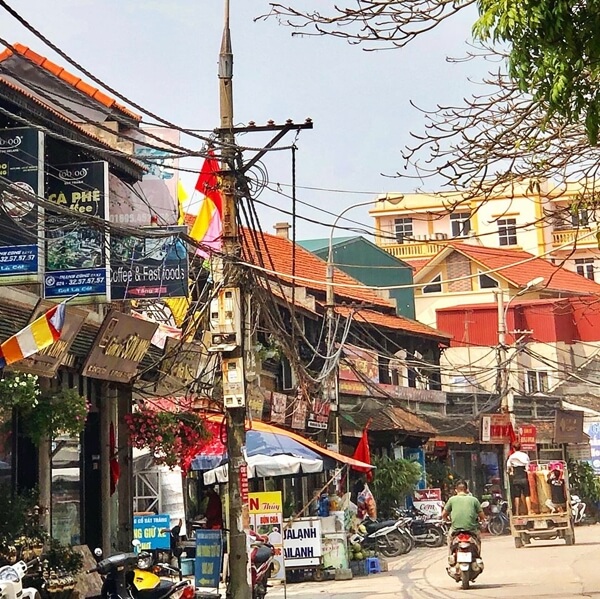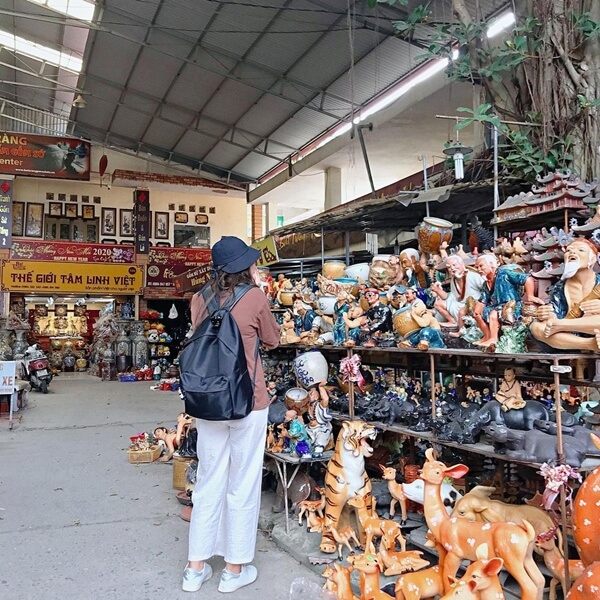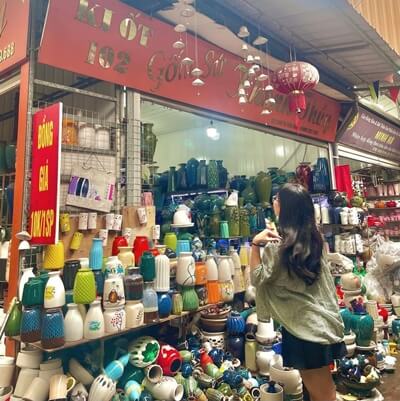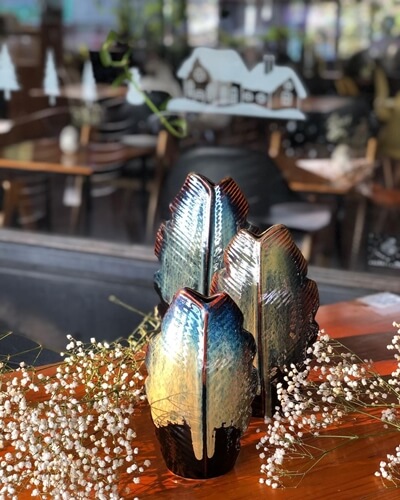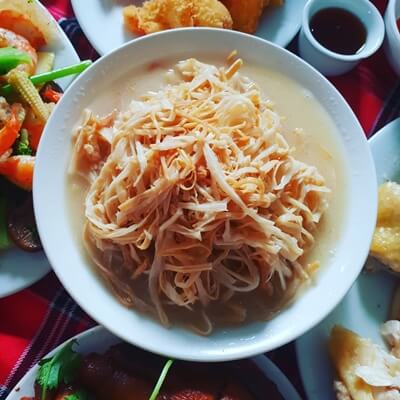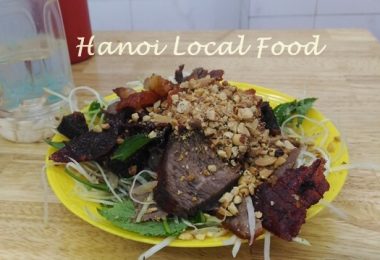Just over 10km from Hanoi’s center lies Bat Trang Pottery Village, a place where centuries-old craftsmanship meets modern curiosity. Nestled in Gia Lam District, this traditional village has been crafting clay into art since the 14th and 15th centuries.
Wandering through Bat Trang, you’ll be captivated by rows of stalls showcasing intricate ceramics—bowls, vases, figurines—each piece reflecting the skill passed down by five founding families: Tran, Vuong, Nguyen, Le, and Pham. Their legacy still lives on through the village’s commitment to preserving traditional pottery-making methods.
1. Why Visit?
Bat Trang isn’t just about buying ceramics. It’s a cultural experience. You can watch artisans mold clay by hand, try your own skills at the wheel, or simply soak in the atmosphere of a village where history is baked into every kiln.
1.1. Visitor Info:
- Location: Bat Trang Village, Gia Lam District, Hanoi
- Entrance Fee: 50,000 VND
- Hours: 8:00 AM – 6:00 PM
1.2. Getting There:
The road to Bat Trang is smooth and accessible, perfect for a short ride by motorbike, car, or even bicycle. For those seeking something different, river cruises on the Red River also stop here—though typically only on weekends.
Bat Trang is more than a destination; it’s a journey into the heart of Vietnam’s artistic soul.
2. What to See and Do in Bat Trang Pottery Village
A trip to Bat Trang isn’t complete without getting your hands on some clay. From crafting your own ceramics to exploring charming alleys and colorful markets, there’s plenty to experience in this traditional village.
2.1. Try Your Hand at Pottery
The main draw of Bat Trang is the chance to make your ceramic piece. Scattered around the village, especially near the market, are family-run workshops offering hands-on pottery experiences for a small fee.
At these workshops, you’ll be handed a moist lump of clay and your spinning turntable. Don’t worry if it’s your first time—friendly instructors guide you through every step. You’ll shape your clay into simple items, such as cups or bowls, or try crafting animals if you’re feeling creative.
Once molded, your piece dries for about 30 minutes—some places even offer a quick kiln-fire option. While waiting, you can wander the village or grab a drink. Later, you’ll decorate and glaze your creation before taking it home as a unique souvenir. Prices range from 30,000 to 50,000 VND per item.
2.2. Browse the Bat Trang Pottery Market
The vibrant Bat Trang Pottery Market is a must-visit. Stalls overflow with everything from fine ceramics and art pieces to jewelry, worship items, and quirky souvenirs. The colorful displays make perfect backdrops for memorable photos, so be sure to bring a charged camera.
Prices are reasonable, and bargaining is welcome. If you’re coming by motorbike or car, parking is available right at the market gate. Big buses, however, will drop you off farther away, requiring a short walk.
2.3. Stroll Through Bat Trang Ancient Village
Step into the past as you explore Bat Trang Ancient Village. Narrow brick lanes, mossy walls, and curved tile roofs evoke a timeless atmosphere. It’s a peaceful area perfect for slow walks and spontaneous photos.
You can also visit the communal house and drop by traditional pottery families to see artisans at work. To soak in the full charm of the village, ditch the vehicle and explore on foot.
Bat Trang is more than a pottery hub—it’s a place where tradition lives, creativity flows, and every corner tells a story.
2.4. Rest with a Coffee at Ando Café
After wandering the lively streets of Bat Trang, take a break at Ando Café, a charming spot tucked away above old burnt-brick stairs. The walkway is lined with porcelain plates, each delicately patterned, adding to the village’s signature charm.
Step inside and you’ll find a breezy, wood-accented space filled with sunlight, leafy plants, and the soothing sounds of nature. You can choose to sit indoors or out on the spacious balcony, where wind and warmth mingle in a tranquil embrace.
The café is beautifully infused with Vietnamese architecture and features a small pottery booth where you can browse for souvenirs. Drinks range from coffee and milk tea to refreshing iced lemon—simple, delicious, and affordable at just 15,000–30,000 VND per cup.
2.5. Taste the Flavors of Bat Trang
Bat Trang’s culinary offerings are as authentic as its ceramics. One standout is squid and bamboo shoot soup, a rustic dish deeply tied to the village’s heritage.
You’ll also find flavorful local dishes, such as Bún Mẹt (vermicelli with tofu, pork, and herbs), grilled sweet potato cakes with coconut milk, and fried kohlrabi with squid. Pair your meal with a glass of local wine or a grapefruit-flower-scented tea for a complete experience.
Meals are often served on the village’s own handcrafted ceramics, adding elegance to even the simplest dishes.
Bat Trang invites you to slow down—whether sipping tea on a balcony, browsing pottery in a sunlit market, or savoring a humble bowl of soup. Rest in its cafés, eat like a local, and wander its timeless lanes.
If you’ve never been, take a half-day from Hanoi—perhaps after a stroll around Hoan Kiem Lake—and let Bat Trang’s rhythm pull you into its classic Vietnamese charm.

